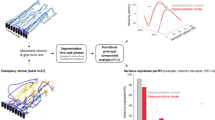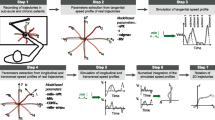Abstract
It is extremely difficult to reduce the relations between the several body parts that perform human motion to a simplified set of features. Therefore, the study of the upper-limb functionality is still in development, partly due to the wider range of actions and strategies for motor execution. This, in turn, leads to inconsistent upper-limb movement parameterization. We propose a methodology to assess and quantify the upper-limb motor execution. Extracting key variables from different sources, we intended to quantify healthy upper-limb movement and use these parameters to quantify motor execution during rehabilitation after stroke. In order to do so, we designed an experimental setup defining a workspace for the execution of the action recording kinematic data. Results reveal an effect of object and instruction on the timing of upper-limb movement, indicating that the spatiotemporal analysis of kinematic data can be used as a quantification parameter for motor rehabilitation stages and methods.
Access provided by CONRICYT-eBooks. Download conference paper PDF
Similar content being viewed by others
1 Introduction
Motor description of the upper-limb has only been performed on a limited set of restrained tasks, such as pointing [1], reaching [2] or grasping [3], which are rather insufficient as prototypes of the wide range of motor tasks we perform daily. Therefore, it is difficult to establish a solid protocol for motor description of goal-oriented tasks. Traditionally, biomechanical analysis, and specifically the interpretation of kinematic variables has been the main basis for the characterization of movement performance. A solid contribution of the human gait research field has been used as a landmark and starting point for the study of the upper limb’s simplest movements. However, the performance of motor actions seems to be strongly affected by the interconnections between the motor, neural, perceptual and cognitive systems that contribute to purposes such as action perception, understanding and imitation [4]. These systems interdependence makes it difficult to establish a solid protocol for dealing with certain goal-oriented tasks, mainly in what regards to tools to analyse and classify movement data. In this work we intend to characterize the motor skills of the upper-limbs while performing functional and non-functional tasks; identify the tasks and environmental features causative of changes; characterize the upper limb’s functional tasks.
2 Method
2.1 Participants
Ten healthy subjects were recruited to participate in the control group, of which 4 men (mean age = 54.5; SD = 7.85) and 6 women (mean age = 55.83; SD = 7.05). Seven participants took part in the post-stroke group, of which 3 men (mean age = 57.6; SD = 26.08) and 4 women (mean age = 47.25; SD = 10.40).
Exclusion criteria, for both groups, comprised musculoskeletal pathology, back and/or upper-limb pain, central nervous system lesions, including visual or other perceptual deficits, and a Mini Mental State Examination score below 25.
2.2 Motion Capture
Motion-capture recordings: Twelve cameras (Qualisys), with a sampling frequency of 240 Hz were used. Nineteen reflective markers were placed in the following landmarks with participant standing: mid-sternum, C7 and T10, right and left acromion, right and left lateral epicondyles of the humerus, right and left medial epicondyles of the humerus, right and left ulnar styloid apophysis, right and left radial styloid apophysis, right and left third metacarpus (hand), right and left anterior superior iliac spines, and right and left posterior superior iliac spines.
2.3 Procedure
Prior to the experimental session, participants were given the consent form and Mini-Mental State Examination (MMSE) was administered along with a questionnaire regarding medical history. In the experimental sessions the subjects were assessed in sitting position without trunk support, being the seat height adjusted to each participant’s lower leg length, measured from the lateral line of the knee joint to the ground. At the initial position 75 % of the thigh length was seat supported. The target object was placed in a bench, which was 67 cm height, at 3 different angles (0º, 22.5º and 45º). For each angle in the workspace the target was placed in two different distances: at the participant’s anatomical functional distance and at 120 % of this functional distance. Furthermore, the instruction and the object to be manipulated varied. In the intentional instruction (C1), a bottle of water was used, being the participant requested to drink and then return the bottle to the initial position. In the non-intentional instruction, the target was either the bottle of water (C2) or a hard paper tube (C3), being the participant requested to lift it and then return it to the initial position. These conditions were counterbalanced for each participant, as well as the first limb to be evaluated (dominant vs. non-dominant/contralesional vs. ipsilesional). Before the beginning of each trial participants were in rest position, with hands on thigh and looking forward. A beep signalled the beginning of the trial and the participant performed the task at his/her own pace. No instruction concerning the velocity was provided. Three trials were performed for the same condition.
2.4 Analysis
Movement segmentation was automatically performed with Matlab 2013b©, while MUVTIME, a multimodal time series visualization tool [5] operating under Matlab was used for data visualization. A multicriteria analysis algorithm was applied to perform movement segmentation. The algorithm identified a set of task specific events, based on the markers position, tangential velocity and on the angle formed by arm segments. The following events were identified in C1: (a) movement initiation, (b) reach, (c) start of lift, (d) start of drinking, (e) end of drinking, (f) return from lift, (g) land the object, (h) return to resting position and (i) movement ending. For this condition, the drinking time was subtracted from total movement duration in order to prevent bias towards a greater time for this action. In C2 and C3, the same events were identified with exception of (d) and (e) that were replaced by return from lift.
3 Results
The ratio of ‘time until reach’ by total movement duration was analysed for healthy participants and revealed lower values for C1 (Fig. 1).
An ANOVA was conducted for this ratio and revealed a significant difference between conditions F (2, 270) = 43.27, p < 0.001 (C1 vs. C2: p < 0.001; C1 vs. C3: p < 0.001; C2 vs. C3: n.s.), indicating that participants reached the target sooner in C1 in comparison with the other conditions. The same ratio was calculated for post-stroke participants (Fig. 2).
4 Discussion
Results indicate that the functionality of the target as well as the instruction given seem to have an effect in the timing of action initiation. Stroke participants reveal different motor patterns and/or strategies in their attempts to reach the target that are related with their motor impairment and/or rehabilitation level. Therefore, it is unclear whether post-stroke participants are sensitive to the same kinematic variables as healthy participants. The same tendency to reach the target sooner fin C1 is evident, at least for Case 2.
5 Conclusion
We designed an experimental protocol that was able to address motor actions of the upper-limb in activities of daily living, as well as an automatized movement segmentation based on different sources of kinematic data. Our results could give insight to new rehabilitation practices that might improve the patients’ motor capabilities by introducing activities with functional implications to the patients on the rehabilitation sessions.
References
J.F. Soechting, F. Lacquaniti, Invariant characteristics of a pointing movement in man. J. Neurosci. 1(7), 710720 (1981)
C.Y. Wu, C.A. Trombly, K.C. Lin, L. Tickle-Degnen, A kinematic study of contextual effects on reaching performance in persons with and without stroke: influences of object availability. Arch. Phys. Med. Rehabil. 81(1), 95–101 (2000)
N. Yang, M. Zhang, C. Huang, D. Jin, Motion quality evaluation of upper limb target-reaching movements. Med. Eng. Phys. 24(2), 115–120 (2002)
G. Rizzolatti, L. Fogassi, V. Gallese, Neuropsysiological mechanisms underlying the understanding and imitation of action. Nat. Rev. Neurosci. 2, 661–670 (2001)
E. Sousa, T. Malheiro, E. Bicho, W. Erlhagen, J. Santos, A.F. Pereira, MUVTIME: a multivariate time series visualizer for behavioral science, in 7th International Conference on Information Visualization Theory and Applications (IVAPP), Vol. 2. (Rome, 2016), pp. 1–12
Acknowledgments
This work was supported by Fundação Bial (Grant 77/12; Grant 143/14).
Author information
Authors and Affiliations
Corresponding author
Editor information
Editors and Affiliations
Rights and permissions
Copyright information
© 2017 Springer International Publishing AG
About this paper
Cite this paper
Silva, R.M. et al. (2017). Analysis and Quantification of Upper-Limb Movement in Motor Rehabilitation After Stroke. In: Ibáñez, J., González-Vargas, J., Azorín, J., Akay, M., Pons, J. (eds) Converging Clinical and Engineering Research on Neurorehabilitation II. Biosystems & Biorobotics, vol 15. Springer, Cham. https://doi.org/10.1007/978-3-319-46669-9_37
Download citation
DOI: https://doi.org/10.1007/978-3-319-46669-9_37
Published:
Publisher Name: Springer, Cham
Print ISBN: 978-3-319-46668-2
Online ISBN: 978-3-319-46669-9
eBook Packages: EngineeringEngineering (R0)






